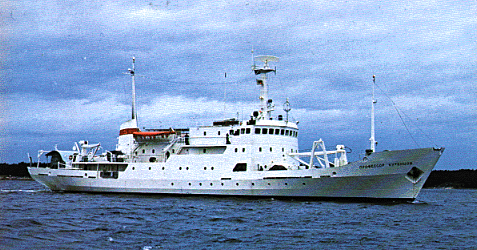
![]()
![]()
Available Facilities |
 In reference
to the University of Washington, the project will be conducted almost
exclusively "off campus." Primary facilites will include the Hakodate
campus of Hokkaido University, the Usujiri Biological Station of Hokkaido
University, and a research vessel provided by the Russian Academy of
Sciences. The Hakodate campus, just five minutes by car from the Port of
Hakodate, will be used as a pre-expedition staging area, serving as a
central point to which all equipment and supplies will be shipped and a
meeting place for all project personnel. A Russian research vessel (see
below) will serve as a means of transporation to and from the islands, and
as a source of all meals (prepared by a cook and support staff attached
to the vessel), sleeping quarters, and as a floating research laboratory
while at sea and when on-site. Large "Achilles" inflatables will be used
to transport equipment and scientists to and from the research vessel.
On the larger islands (e.g., Kunashir, Iturup, Urup, and Paramushir),
four-wheel drive Russian military vehicles will be used to move between
distant collecting sites. In reference
to the University of Washington, the project will be conducted almost
exclusively "off campus." Primary facilites will include the Hakodate
campus of Hokkaido University, the Usujiri Biological Station of Hokkaido
University, and a research vessel provided by the Russian Academy of
Sciences. The Hakodate campus, just five minutes by car from the Port of
Hakodate, will be used as a pre-expedition staging area, serving as a
central point to which all equipment and supplies will be shipped and a
meeting place for all project personnel. A Russian research vessel (see
below) will serve as a means of transporation to and from the islands, and
as a source of all meals (prepared by a cook and support staff attached
to the vessel), sleeping quarters, and as a floating research laboratory
while at sea and when on-site. Large "Achilles" inflatables will be used
to transport equipment and scientists to and from the research vessel.
On the larger islands (e.g., Kunashir, Iturup, Urup, and Paramushir),
four-wheel drive Russian military vehicles will be used to move between
distant collecting sites.
|
 The R/V Professor Bogorov, chartered vessel for the IKIP 1994 expedition.
|
 Just prior to
each annual expedition, the Japanese and U.S. teams will converge on
Hakodate, where they will be met by the research vessel carrying members
of the Russian team. At the termination of each field season, the vessel
will again make port at Hakodate, where all collections will be unloaded and
transported to Usujiri Biological Station, where (1) sorting,
identification, curation, will be completed; (2) all remaining field data
will be entered into the database; and (3) specimens will be prepared for
shipment to the appropriate institution. Located at the mouth of Volcano
Bay, Hokkaido, approximately 42 km from Hakodate City, the Usujiri
Biological Station is well equipped with microscopes and other essential
gear, and provides more than enough laboratory space for our needs. A
dormitory on the premises, with room for 54 persons, will be available
for our exclusive use. Just prior to
each annual expedition, the Japanese and U.S. teams will converge on
Hakodate, where they will be met by the research vessel carrying members
of the Russian team. At the termination of each field season, the vessel
will again make port at Hakodate, where all collections will be unloaded and
transported to Usujiri Biological Station, where (1) sorting,
identification, curation, will be completed; (2) all remaining field data
will be entered into the database; and (3) specimens will be prepared for
shipment to the appropriate institution. Located at the mouth of Volcano
Bay, Hokkaido, approximately 42 km from Hakodate City, the Usujiri
Biological Station is well equipped with microscopes and other essential
gear, and provides more than enough laboratory space for our needs. A
dormitory on the premises, with room for 54 persons, will be available
for our exclusive use.
|
![]()